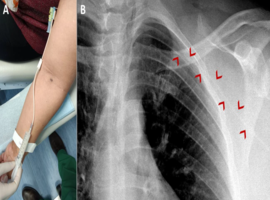Marisa C. Couto*, Nuno Teixeira Tavares and Miguel Barbosa
Serviço de Oncologia Médica, Unidade Local de Saúde de São João; Porto, Portugal
*Corresponding author: Marisa C. Couto, Serviço de Oncologia Médica, Unidade Local de Saúde de São João; Porto, Portugal. E-mail: coutomarisa18@gmail.com
Received: July 20, 2025; Accepted: August 02, 2025; Published: August 15, 2025
Citation: Couto MC, Tavares NT, Barbosa M. Totally Implanted Venous Catheter: What Can Go Wrong? Clin Image Case Rep J. 2025; 7(5): 569.


